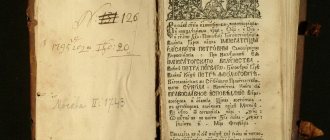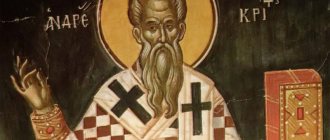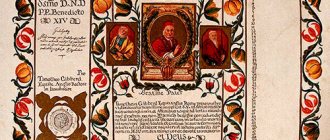What is a catechism
Translated from Greek, this word means teaching, instruction or instruction. Catechisms were Christian books published in the Middle Ages. In the published manuals for Christians, various authors gave an answer to the question of interest to the people.
Orthodox Catechism
Here you could read about the basics of religion, the meaning of the Ten Commandments and everything about the sacraments.
Read about some of God's commandments:
- Commandment to respect parents
- Commandment "Thou shalt not steal"
- Commandment “Do not remember the Lord in vain”
It is interesting that the catechism was issued only to priests, who had to convey it orally to the people. In a secular society, a catechism is a set of unwritten rules for a certain circle of people.
If for Catholics this book is symbolic, then for Orthodox it remains as a guide for Christians.
In the draft Orthodox book of questions and answers submitted to the priests for consideration, the main chapters are the following:
- Fundamentals of Orthodoxy.
- Fundamentals of Canons and Liturgies in Orthodoxy.
- Fundamentals of the morals of Orthodox education.
- Basic social concepts of the Russian Orthodox Church.
- Basic beliefs of the Russian Church regarding the dignity, rights of man and his freedom.
- Basic principles of relationships with people of other faiths.
Important!
In the catechism, religious doctrines are described in simple language accessible to a wide range of people, but the meaning of the messages themselves does not change. This book must fully correspond to the messages of the Holy Fathers of the Church. Holy passages in the book of questions and answers can only be quoted with references and explanations.
CATECHISM
CATECHISIS, catechism (Greek ϰατήχησις - teaching, instruction, announcement, from ϰατηχέω - to teach, teach), 1) a statement of the foundations of k.-l. knowledge, ch. arr. religious creeds (see Catechesis).
2) A book containing the main. provisions of Christian doctrine, presented, as a rule, in the form of questions and answers; genre of doctrinal literature (a similar genre form of presenting the fundamentals of doctrine exists in Buddhism, Islam, Mithraism). Examples of letters. fixations of baptismal catechesis in the Christian Church of the first centuries are “Proof of the Apostolic Preaching” sschmch. Irenaeus of Lyon (2nd century), “Catechetical and Secret Teachings” (347–348) by St. Cyril of Jerusalem, “Great Catechetical Discourse” by St. Gregory of Nyssa (4th century), “On the teaching of the catechumens” (400) bl. Augustine, and according to some researchers, also the Didache (late 1st century). In the Middle Ages, as a systematic the catechetical instructions to the Creed and the Lord's Prayer, the Ten Commandments of God (Decalogue) and church sacraments were added, which formed the structural basis of K. as an educational and didactic. benefits.
Actually the first book called. "TO." was written in North. Africa Catholic Portuguese Ep. Diogo Ortis de Villegas – “Cathecismo Pequeno da doctrina...” – and published in Lisbon in 1504. Most significant. K. (received other names: doctrina, summa, enchiridion, compendium, institutio, elementa) appeared in the 16th century. in the West Europe in connection with the Reformation. In the Protestant tradition, along with K., the authors of which were F. Melanchthon (1524), I. Bugenhagen (1525), I. Brenz (1527–28), A. Althamer (1528), M. Mazvydas (1547; the first book on Lithuanian), center. place is occupied by “Enchiridion. Der kleine Catechismus… für die gemeine Pfarhern und Prediger…” (“Small” K.) and “Deutsch Catechismus” (“Big” K.) (both 1529) by M. Luther. Intended as guidance respectively for the family and for the church community, the Small and Large Catechisms are elevated to the category of doctrinal books of Lutheranism. Their characteristic features are an organic connection with the Bible, preaching style, and clarity of language.
Catholic K. 16th century, among which are the Enchiridion by I. Gropper (1538), the Summa by P. Canisius (1555) and the especially popular Doctrine by Cardinal R. Bellarmine (1st ed. - 1597), translated into 56 languages were a reaction to Luther's catechisms. Official Catholic status The church has a specially created decree of the Council of Trent “Catechismus romanus” (“Roman Catechism”, 1566). Due to the Catholic missions to America became the first printed books on this continent (Mexico City, 1543; Lima, 1584).
By the 16th century include classic K. Reformed ["Geneva Catechism" by J. Calvin (1542) and "Heidelberg Catechism" (1563); from 1618 both are symbolic books of the Reformed] and Anglican (“A Catechism, that is to say, an Instruction to be learned of every person before he is brought to be confirmed by the Bishop”, 1553) churches.
Subsequently in the West. Not only various types appeared in Europe. forms of K., varying depending on the pastoral and practical. needs and specific addressees, but also attempts to conceptually rethink this genre. Thus, along with illustrated, poetic, missionary, apologetic, diocesan, children's, school catechisms, catechisms for adults and for clergy, there are catechisms built on the principle of following Sacred history (“Catéchisme historique” by C. Fleury, 1683) or based on from personal-existential questions of human existence (“De nieuwe Katechismus”, 1966). Catechism The literature of the “third world” countries is distinguished by a clear social orientation and connection with liberation theology (Nicaragua - “The Gospel in the Solentinam” by E. Cardenal, 1975; Brazil - “From Life to the Bible”, 1972). Originated in Catholicism in the beginning. 19th century the idea of one, or the so-called. Ecumenical, K. (“Catechism of the French Empire”, 1806) was embodied in the “Catechism of the Catholic Church” created under Pope John Paul II in the spirit of the decisions of the Vatican II Council (1992, Russian translation 1998).
Having emerged a century later than in the West, Orthodox Christians formally differed only in their expanded structure due to the introduction of certain additions. sections [about the gifts of the Holy Spirit, the fruits of faith, about “last things” (eschatology), the Beatitudes]. One of the earliest Orthodox Christians, the Greater Catechism of Laurentius Zizanius (1st quarter of the 17th century; Church Slavonic edition, 1627), became widespread only among Russians. Old Believers. The “Confession of Faith” of Patriarch Cyril Lucaris of Constantinople, published in Geneva in 1629, was not accepted among the Orthodox community due to its obvious Calvinist orientation. An outstanding monument to the Orthodox catechism. litera is originally written in Latin “Orthodox Confession of Faith of the Catholic and Apostolic Church of the East” by Met. Peter's Mogila (Latin - 1642; Greek - 1643; Church Slavonic edition - 1685). Having played means. role in the history of theology, this is an essay with con. 19th century caused controversy over the adequacy of the presentation of Orthodox doctrine and the degree of Catholic influence on the work. scholastics. The first proper Russian book in the K. genre - “A Primer, or the First Teaching of a Youth with a Catechism” (1720) - belongs to Archbishop. Feofan Prokopovich. K most means. K. rus. Orthodoxy include “Orthodox Teaching” (1765) Met. Plato (Levshin), “Abridged Catechism” (1782) and “Long Catechism” (1783) for the youth of F. I. Yankovic de Mirievo, “Long Christian Catechism of the Orthodox Catholic Eastern Church” (1823) and “The Beginnings of Christian Teaching, or Brief Sacred History and Short Catechism" (1828) Metropolitan. Philaret (Drozdova), “The Experience of the Christian Orthodox Catechism” (1924) Metropolitan. Anthony (Khrapovitsky), “Orthodox Catechism” (early 1950s, ed. 1981) by ROCOR Bishop Alexander (Semyonov-Tyan-Shansky).
Among the K. other local Orthodox churches: “Orthodox Catechism” (1940, Russian translation 1954) Czech. Ep. Gorazda (Pavlika); published in America “The Orthodox Faith” (“Orthodox Faith”, vol. 1–4, 1971–75) by Protopresbyter Thomas Hopko and “A new-style Catechism on the eastern orthodox faith for adults” (“New Catechism of the Eastern Orthodox Faith for adults", 1969); family K. european French-speaking communities of the Patriarchate of Constantinople “Dieu est vivant” (“God is alive”, 1979).
3) Academic discipline in Christian schools.
The history of the Catechism
Cyril of Jerusalem, Augustine and John Chrysostom wrote entire epistles, which later became models for writing subsequent catechisms.
Catechism - a short guide to the Orthodox faith
From these books, Christian converts obtained information:
- about the Sacraments of the Church and the operation of the Holy Gifts;
- about the symbols of the Orthodox faith;
- about the meaning of the main prayer “Our Father”;
- about the Ten Commandments and the Eight Deadly Sins.
About sins in Orthodoxy:
- Sin of laziness
- Sin of Wrath
- Sin of slander
For the first time, a book of questions and answers in the form of a textbook for clergy was compiled by Bruno of Würzburg in the 11th century.
At the end of the 13th century, Thomas Aquinas preached beautiful sermons explaining in accessible language the concepts of the creeds, the Lord's Prayer and the basic commandments given by God through the Apostle Moses.
Until 1254, no explanation of church concepts was given at services, and only the Council of Albia obliged priests to explain to believers the meaning of the creeds during church services.
With the advent of Protestantism, catechetical activity reached its peak with the publication of the first Catechism, authored by the Protestant Althamer.
In 1541, Calvin issued his own copy, a book of questions and answers in French and then in Latin.
In 1642 I saw the first Orthodox copy, written by Peter Mogila.
Interesting! In each country, at a certain time, printed messages appear, designed to reveal to Christians the subtleties of Catholic and Orthodox beliefs.
The need for every Christian to know the basics of Christian doctrine
The Importance of Reason in Religious Life
Why, as mentioned above, is knowledge of the basics of Christian doctrine necessary for “every Christian”? Isn’t it enough for a normal spiritual life to limit yourself to personal piety: prayer, good deeds, visiting temple, etc.? As Holy Scripture indicates, serving God requires the participation of the whole person, including both body and soul with all its powers (mind, feelings and will):
“Thou shalt love the Lord thy God with all thy heart, and with all thy soul, and with all thy mind” Matt. 22, 37
Limiting spiritual life to only one area (for example, the area of emotions) does not give a Christian the opportunity to build his life as a reasonable service to God (Rom. 12: 1).
The opposition of faith and reason is alien to Orthodoxy - they are inextricably linked and presuppose each other. There can be no faith without reason because:
1) a person cannot believe in something about which he knows nothing;
2) faith itself must be conscious, meaningful. Ap. Paul testifies:
“I know in whom I have believed” 2 Tim. 1:12
At the same time, reason also needs faith. For example, a condition for any cognitive activity is confidence in the existence of objective truth as such.
Scientific knowledge of the world is based on two premises taken for granted:
1) the belief that the world around us really exists; 2) faith in human cognitive abilities, in the fact that our feelings and reason do not deceive us.
The exclusion of reason from the religious sphere negatively affects the entire structure of a person’s spiritual life. For example, such phenomena of religious life as fanaticism, unhealthy mysticism, ritual belief, heresies, schisms are often caused by ignorance in matters of doctrine.
What is needed for salvation
The purpose of human life is to achieve salvation. The Long Catechism teaches that “to please God and to save the soul, the following are necessary: a) “the knowledge of the true God.” But what does it mean to “know God”? Since God is a Person, knowledge of Him is possible only through a personal relationship, that is, in the experience of communication with God. Therefore, true knowledge of God is not a way of thinking, but, first of all, a way of life, life in direct unity with God. b) “right faith in Him.” That is, a person’s presence of correct ideas about God, about His relationship to the world, since false faith and superstition, combining a person’s soul with untruth, alienate him from God. c) “life by faith and good works.” In other words, bringing a person’s entire life into conformity with the will of God.
The term “orthodoxy,” which we use to refer to our faith, is a translation of the Greek term “orthodoxy.” The word “orthodoxy” consists of two parts: “orthos” means “straight, true”, and “doxa” can have two meanings: a) opinion, idea; b) fame. The Greeks understand the word “orthodoxy” as “right-mindedness,” but this word was translated into the Slavic language (apparently by St. Cyril and Methodius themselves) as “Orthodoxy.” It seems that the Slavic translation better expresses the very essence of the Christian faith as a way of life, and not just a way of thought.
The desire for communion with God and fulfillment of God's will is the core of the spiritual life of an Orthodox Christian. Through personal communication with God (primarily prayer and participation in the Church Sacraments), we receive the grace that sanctifies us, the spiritual strength necessary for a righteous life, and through exercise in virtue we achieve spiritual and moral perfection.
Authorship and creation of a single document
At the beginning of the 19th century, the church used different editions of the confessional book. Most often these were the works of two metropolitans: Peter Mogila and Plato. Later, other publications were published on their basis, which were repeatedly subjected to harsh criticism from the Orthodox Church. To eliminate all the comments, it was decided to publish a combined version.
Work on a new book of catechism began in 1822, and its author was Archbishop of Moscow and Kolomna Filaret. A year later, the Synod approved the final edition along with the edits, and the document was officially recognized as a guide to the Christian faith. Later, changes were made, and therefore it was republished more than once. However, until now, Filaret’s work is positioned as canonical, containing the basic dogmas and postulates of the Orthodox Church.
The document, which collected all the best from previous editions, was printed towards the end of 1824 under the title “Short Catechism”, but the expanded version was called “Long”.
Work on a new catechumen book began in 1822
Criticism of the confessional document
The first versions of the catechetical books appeared during a period of active criticism of the translations of the Gospel, which came from the pen of the Russian Bible Society. Conservatives from the government and the church especially strongly criticized the activities of the RBO. They insisted that literary Russian was not suitable for religious use, and therefore all works should be written in Church Slavonic.
A. S. Shishkov, being the Minister of Public Education, advocated equality between the Russian language and the church dialect. At the same time, Metropolitan Photius compared the new publications to “water from a ditch.”
Critics of the new catechism believed that modern translations could cause the spread of heresy.
Interesting information









